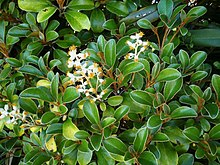Brachyglottis
| Brachyglottis | |
|---|---|

| |
| Brachyglottis elaeagnifolia | |
| Scientific classification | |
| Kingdom: | Plantae |
| Clade: | Tracheophytes |
| Clade: | Angiosperms |
| Clade: | Eudicots |
| Clade: | Asterids |
| Order: | Asterales |
| Family: | Asteraceae |
| Subfamily: | Asteroideae |
| Tribe: | Senecioneae |
| Genus: | Brachyglottis J.R.Forst. & G.Forst. |
| Species | |
|
About 39 | |
| Synonyms[1] | |
|
Urostemon B.Nord. | |
Brachyglottis is a genus of flowering plants in the family Asteraceae. The genus was erected on November 29, 1775,[2][3] by Johann Reinhold Forster and Georg Forster. The name was derived from the Greek brachus ("short")[4] and glottis ("the vocal apparatus of the larynx"[5]) a reference to the size of the ray florets.[6]
The genus is almost entirely native to New Zealand, except for B. brunonis, which occurs in Tasmania.[7]
In cultivation in the UK, the cultivar 'Sunshine' has received the Royal Horticultural Society's Award of Garden Merit.[8]
Diversity
[edit]

There are about 39 accepted species names.[9] Most species were transferred to the genus from Senecio in 1977 and 1978.[10][11]
Species include:[9]
- Brachyglottis adamsii
- Brachyglottis arborescens – Three Kings rangiora
- Brachyglottis bellidioides
- Brachyglottis bidwillii
- Brachyglottis bifistulosa
- Brachyglottis brunonis
- Brachyglottis buchananii
- Brachyglottis caledoniae
- Brachyglottis cassinioides
- Brachyglottis christensenii
- Brachyglottis cockaynei
- Brachyglottis compacta (Kirk) B.Nord. – Wairarapa groundsel, piecrust plant
- Senecio compactus Kirk
- Brachyglottis elaeagnifolia (Hook. f.) B.Nord.
- Senecio elaeagnifolius Hook. f.
- Brachyglottis forsteri
- Brachyglottis greyi (Hook. f.) B.Nord.
- Senecio greyi Hook. f.
- Brachyglottis haastii
- Brachyglottis hectorii
- Brachyglottis huntii (F.Muell.) B.Nord.
- Senecio huntii F.Muell.
- Brachyglottis lagopus (Raoul) B.Nord.
- Senecio lagopus
- Brachyglottis lapidosa
- Brachyglottis laxifolia (Buchanan) B.Nord.
- Senecio laxifolius Buchanan
- Brachyglottis matthewsii
- Brachyglottis monroi (Hook. f.) B.Nord. – Monro's ragwort
- Senecio monroi Hook. f.
- Brachyglottis myrianthos
- Brachyglottis orbiculatus
- Brachyglottis pentacopa
- Brachyglottis perdicioides (Hook. f.) B.Nord.
- Senecio perdicioides Hook. f.
- Brachyglottis remotifolia
- Brachyglottis repanda J.R.Forst. & G.Forst. – rangiora, pukapuka, hedge ragwort
- Brachyglottis revoluta
- Brachyglottis rotundifolia – muttonbird scrub
- Brachyglottis saxifragoides (Hook. f.) B.Nord.
- Senecio saxifragoides Hook. f.
- Brachyglottis sciadophila
- Brachyglottis southlandica
- Brachyglottis spedenii
- Brachyglottis stewartiae (J.B.Armstr.) B.Nord.
- Senecio muelleri Kirk
- Senecio stewartiae J.B.Armstr.
- Brachyglottis traversii (F.Muell.) B.Nord.
- Brachyglottis turneri
References
[edit]- ^ Germplasm Resources Information Network (GRIN) (1996-09-17). "Genus: Brachyglottis J.R.Forst. & G.Forst". Taxonomy for Plants. USDA, ARS, National Genetic Resources Program, National Germplasm Resources Laboratory, Beltsville, Maryland. Archived from the original on 2010-05-28. Retrieved 2008-04-10.
- ^ "Index Nominum Genericorum database". ING Database - Smithsonian Institution. 1996-02-09. Retrieved 2008-04-10.
- ^ Botanic Garden and Botanical Museum Berlin-Dahlem (1997-09-24). "Brachyglottis J.R.Forst. & G.Forst". NCU-3e. Names in current use for extant plant genera. Freie Universität Berlin. Retrieved 2008-04-10.
- ^ Liddell, H. G.; Robert Scott. "bra^chus , eia (Ion. ea Hdt.5.49), u, dat. pl". A Greek-English Lexicon. Tufts University. Retrieved 2008-04-10.
- ^ WordNet. "a lexical database for the English language". Cognitive Science Laboratory of Princeton University. Retrieved 2008-02-24.
- ^ Coombes, A. J. (1985). "Section 1". Dictionary of Plant Names. Timber Press. pp. 207 pages. ISBN 0-88192-294-3. Retrieved 2008-04-10.
- ^ Wagstaff, Steven J.; Breitwieser, Ilse (2004). "Phylogeny and Classification of Brachyglottis (Senecioneae, Asteraceae): An Example of a Rapid Species Radiation in New Zealand". Systematic Botany. 29 (4): 1003–1010. doi:10.1600/0363644042450991. JSTOR 25064027. S2CID 86053441.
- ^ "Brachyglottis (Dunedin Group) 'Sunshine'". www.rhs.org. Royal Horticultural Society. Retrieved 12 April 2020.
- ^ a b Brachyglottis. The Plant List.
- ^ Germplasm Resources Information Network (GRIN). "GRIN Species Records of Brachyglottis". Taxonomy for Plants. USDA, ARS, National Genetic Resources Program, National Germplasm Resources Laboratory, Beltsville, Maryland. Archived from the original on 2012-12-11. Retrieved 2008-04-10.
- ^ Edgar, E.; H. E. Connor (1983). "Nomina Nova III, 1977–1982". New Zealand Journal of Botany. 21 (4): 421–441. Bibcode:1983NZJB...21..421E. doi:10.1080/0028825x.1983.10428573. 0028-825X/83/2104-0421.
![]() Media related to Brachyglottis at Wikimedia Commons
Media related to Brachyglottis at Wikimedia Commons
